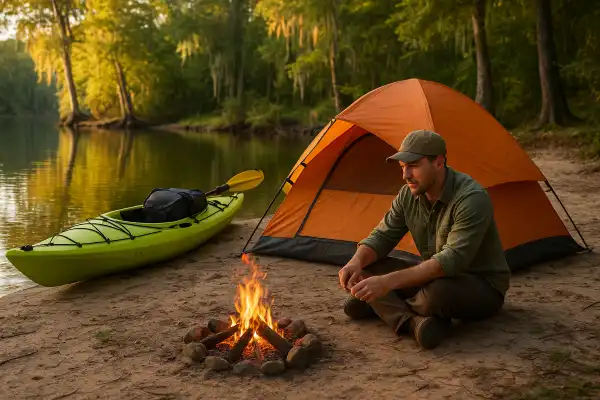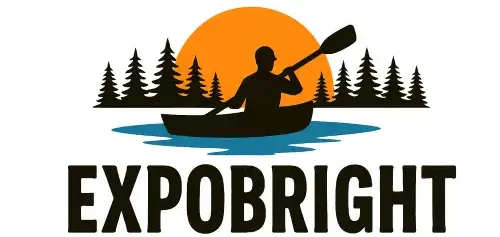Where can you kayak camp in South Carolina remains one of the most frequent questions I receive from paddlers seeking overnight adventures beyond day trips. The Palmetto State’s diverse waterways—from mountain-fed lakes to blackwater rivers and pristine barrier islands—create an almost overwhelming array of possibilities for those ready to combine paddling with camping.
During my early days guiding trips through Florida’s mangroves, I often heard paddlers mention South Carolina as their ultimate destination for multi-day expeditions. The state’s unique geography offers everything from challenging coastal paddles to gentle river meanders, each with distinct camping opportunities that cater to different skill levels and preferences.
Where can you kayak camp in South Carolina?
South Carolina offers exceptional kayak camping across coastal barrier islands, blackwater rivers, and mountain lakes, with destinations ranging from permit-required pristine preserves to established state park campgrounds. The state’s diverse waterways include the 62-mile Edisto River Canoe and Kayak Trail, Lake Jocassee’s boat-in backcountry sites, and numerous coastal islands accessible only by paddle.

Capers Island: pristine barrier island camping
Capers Island stands as South Carolina’s premier coastal kayak camping destination, requiring permits from the South Carolina Department of Natural Resources for overnight stays, with camping limited to designated areas on the island’s northern and southern tips. This three-mile barrier island showcases the Lowcountry’s natural ecosystem in its undeveloped state, featuring maritime forest, salt marsh, and pristine beaches.
Launch from Gadsdenville Public Boat Landing off Route 17 for the challenging 2.5-mile paddle through narrow tidal creeks and vast estuaries. Permits accommodate up to 40 people per night divided into maximum 20 groups, obtained by calling the DNR Charleston office at (843) 953-9360 during business hours. Timing your departure with tidal conditions proves critical—launch during low tide and plan your return during rising tide to navigate the shallow grass-filled channels successfully.
The island offers unparalleled wildlife viewing opportunities. Paddlers regularly encounter dolphins, blue crabs, moon jellyfish, and sandbar sharks, while the island hosts over 294 species of migratory birds. The famous “Bone Yard” on the island’s eastern side features dramatic stands of weathered palmetto trees, creating an otherworldly landscape perfect for sunrise photography.
Edisto River: blackwater paradise with multiple camping options
The Edisto River, recognized as one of the longest free-flowing blackwater rivers in North America, offers the 62-mile Edisto River Canoe and Kayak Trail with camping opportunities at two state parks and unique treehouse accommodations. Carolina Heritage Outfitters provides the only treehouse camping experience on the Edisto River, featuring three elevated structures accommodating 3-8 campers along the river’s edge.
Traditional camping options include Colleton State Park and Givhans Ferry State Park, both offering first-come, first-served campsites with water and electrical hookups, heated restrooms, and convenient shower facilities. The trail also features a backcountry campsite provided by a private timber company, offering more primitive camping experiences for those seeking solitude.
The Edisto’s tea-colored water flows through diverse landscapes of cypress-tupelo swamps, past white sandy beaches, and beneath canopies of ancient live oaks draped in Spanish moss. The river’s freshwater layer allows alligators to extend their range downstream, while the warm spring weather encourages active wildlife behavior that enhances the paddling experience.
Lake Jocassee: mountain lake boat-in camping
Devils Fork State Park provides access to Lake Jocassee’s boat-in backcountry camping area on the northern shore at the base of Musterground Mountain, featuring 25 primitive campsites accessible only by paddle. Lake Jocassee spans 7,565 acres of crystal-clear mountain water, fed by four mountain streams and several waterfalls, creating ideal conditions for trout fishing and swimming.
The Double Springs boat-in camping area offers tent pads and fire rings in a completely primitive setting with no amenities beyond what you carry in. Alternative accommodations include the main campground’s 59 lakeside sites with hookups and 25 rustic tent-only sites for those preferring established facilities.
Lake Jocassee’s 90 miles of undeveloped shoreline and fewer than 40 homes create an pristine mountain environment, while the steep terrain eliminates mosquito breeding grounds, providing comfortable camping conditions even in summer. Waterfalls cascading directly into the lake from steep wooded slopes offer spectacular scenery accessible only by boat.
Pee Dee River system: blackwater river adventures
The Little Pee Dee and Great Pee Dee Rivers offer extensive blackwater paddling opportunities through cypress-tupelo swamps, white sandy beaches, and pristine Coastal Plain wilderness. Little Pee Dee State Park provides 55 campsites with picnic tables and fire rings, plus group sites accommodating 20-35 people, along with boat launches for easy river access.
The Great Pee Dee’s 70-mile scenic river segment from Highway 378 to Winyah Bay features numerous public boat landings and pristine camping opportunities on sandy beaches and elevated areas above the flood plain. Experienced paddlers regularly organize multi-day expeditions, camping on high ground and exploring interconnected waterways that create maze-like adventures through flooded forests.
The river system encompasses nearly 29,000 acres within Waccamaw National Wildlife Refuge, providing exceptional wildlife viewing opportunities including great blue herons, wood storks, and American alligators. These free-flowing, unaltered river systems serve as critical habitat for resident and migratory fish species, supporting excellent fishing for redbreast, bass, and catfish.
Essential planning considerations
Permits require advance planning—Capers Island camping permits must be obtained during business hours, while other locations operate on first-come, first-served or reservation systems. Tidal timing proves crucial for coastal destinations, requiring consultation of tide charts and understanding of local water conditions.
Insect protection becomes essential, particularly during warmer months when mosquitoes and no-see-ums can be overwhelming without proper preparation including head nets and thermacell devices. Essential gear includes waterproof storage, first-aid kits, maps, binoculars for wildlife viewing, and fishing equipment for destinations known for excellent angling opportunities.
Conclusion
Last summer, I guided a family from Ohio on their first kayak camping expedition to Capers Island, watching their amazement as we paddled through mirror-calm waters at sunrise while dolphins surfaced nearby. Following proper preparation guidelines—from permit acquisition to gear selection and tidal timing—transformed what could have been a stressful adventure into their most memorable family vacation. Having detailed knowledge of access points, camping regulations, and local conditions makes the difference between a magical wilderness experience and a potentially dangerous or disappointing trip. South Carolina’s kayak camping destinations reward those who invest time in proper planning with unforgettable adventures across some of the Southeast’s most pristine waterways.
